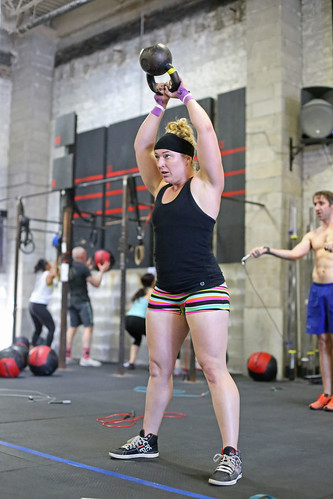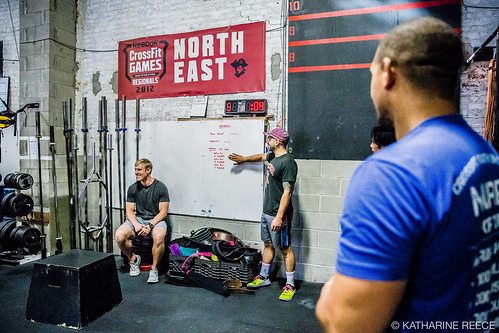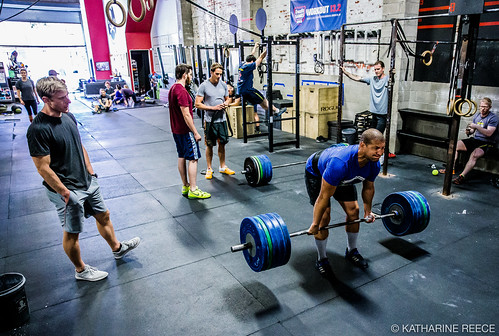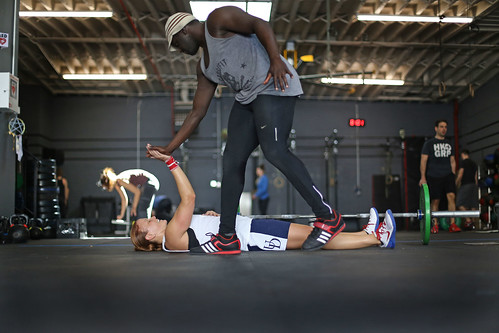What Makes a Great CrossFit Group Class
 Friday, June 17, 2016 at 2:59PM
Friday, June 17, 2016 at 2:59PM  Anyone familiar with CrossFit knows that no two affiliates are alike. CrossFit’s fierce aversion to traditional franchise models means that each gym is able to express their community, culture, and training biases however they please. With over 13,000 affiliates worldwide, there is a massive spectrum of class structures and styles—however, there are some fundamental principles which can and should be applied to all CrossFit affiliates.
Anyone familiar with CrossFit knows that no two affiliates are alike. CrossFit’s fierce aversion to traditional franchise models means that each gym is able to express their community, culture, and training biases however they please. With over 13,000 affiliates worldwide, there is a massive spectrum of class structures and styles—however, there are some fundamental principles which can and should be applied to all CrossFit affiliates.
In today’s article, we’re going to talk about some of the principles that make a great CrossFit group class. For coaches, this article can serve as a due-diligence checklist to make sure you’re providing a professional, inclusive, and effective training session. For athletes, this article will be a helpful resource to give you a sense of what standards you should have for choosing a CrossFit gym. Because different gyms run different programming styles and structure classes differently, we’re focusing today on principles that can be applied to almost any gym.
Greeting
Something that often gets overlooked at affiliates is the initial point of contact with new members or drop-ins. Your seasoned members may know what to expect but someone walking into your gym for the first time may not be sure what to do—from where to put their things, who to talk to, whether they should start warming up, etc. (Not to mention that new person is probably a bit scared or intimidated.) I’ve been to affiliates where I was immediately greeted and given a lay of the land by a coach, and others where I awkwardly walked around for 10 minutes trying to figure out who the coach was and whether I needed to do anything before class, like sign a waiver.
At CrossFit South Brooklyn (CFSBK), we have a Front Desk that greets everyone who walks in the door and checks them into class. Our Front Desk staff shows anyone not familiar with our space where they can change, who the coach will be, where to warm up, etc. If your gym doesn’t have a front desk (and we didn’t for years), it’s up to the coaches to spot unfamiliar faces and proactively introduce themselves and assist however they can. This requires going the extra mile—but there’s nothing worse than walking into a business and being ignored when you need help. When coaches greet folks and establish a warm vibe, that impacts current members and can also create a trickle-down effect. Members who see this will be more likely to perpetuate the good vibes and introduce themselves to new people.
Class Structure
We’ve talked about this extensively on ITA but put simply: a good class is a well-organized class. Being well organized means having a clear structure for each group class that coaches follow consistently, to the point that members know what to expect.
At CFSBK, we always start classes with soft tissue movement prep and our Question of the Day, which usually leads into standardized warm-ups or skill work. Some gyms perform line drills, get folks running or rowing, or something similar. The point is that if you’re going to be training seriously, there needs to be some dedicated movement prep beforehand. That extends to all other portions of class—there should be ample time to warm up whether you’re performing “Fran” or a 1RM Deadlift.
For the rest of class, whether you’re going into a lifting segment, some skill work, or the metcon, each segment should be explained clearly (more on this below) and ideally follow clear time stamps to communicate exactly how much time everyone will be spending on a particular portion of class. As a participant, it is a much different experience to know you’ve got 18 minutes to get through your warm-up and work sets on the back squat, versus the coach arbitrarily saying you’re done when you’re not, and moving on to the next segment. Having a efficient plan for time management—which includes starting classes on time (this is so important!)—shows that the coach is prepared and values your time.
For example, an hour-long group class might be organized as follows:
Intros/Movement prep (3-5:00)
Standardized or specific warm-ups (8-10:00)
White board brief (2-3:00)
Lifting Segment (15-20:00)
White board brief (2-3:00)
Metcon (Varies, but includes warm-up time, 10-15:00+)
Again, this is just one of literally countless templates you can use, depending on what’s on tap for your training that day.
 White Board Explanations
White Board Explanations
The whiteboard is where the class comes together and the coach explains the “plan” for the following segment. Explaining the programming and demoing movement at the white board should accomplish a few things: explaining what the programming entails, explaining the intention of the programming, and providing scaling options. This time should also provide an opportunity for members to ask questions if anything is unclear. This can and should also include logistics like assigning rack stations, assisting with partnering people based on their Rx, and any other logistics so that members can focus on the workout and not where they should be. The goal is to be clear about expectations and minimize any ambiguity regarding how members should approach the lift or workout.
Below is an example of a white board brief before a back squat segment. Note that at CFSBK, we divide our programming into two levels: Fitness and Performance. The Fitness folks tend to follow slightly more basic programming, whereas our Performance people have advanced to more intermediate level programming.
Explain the programming
“We’ve got back squats on tap today, with Fitness working up to three sets of five reps across and Performance is taking three attempts to work up to a 3RM. Everyone start with the empty bar and take 3-5 progressive warm-up sets before getting into your work sets.”
Explain the intention of the programming and/or how it fits into a larger context of your programming cycle
“Fitness should aim to hit about 5-10lbs heavier than last week and Performance is looking to hit a 3RM today. Performance, make your first attempt similar or above your 5RM from last week and see how you feel for the following attempts. Everyone, make sure to rest 3-4 minutes between attempts. You have 15 minutes. Watch the clock to make sure you get all your sets in before we move on. Next week we’ll attempt a 1RM, so pay attention to how this feels and think about what you might shoot for.”
Scaling options to preserve stimulus of workout
“If you’re new to us, you should focus on a medium heavy 3x5 on the Fitness programming track. Let us know if you need assistance on what weights to shoot for today. If you’re following Performance but are still sore from ‘Cindy’ two days ago, you might not hit a new 3RM today, but do your best to work up to a heavy triple. Make sure to use spotters. Today should be a heavy day.”
 Coaching
Coaching
It goes without saying that the coaching quality always informs the quality of the overall class. Coaches who are disengaged, checking their phones, not correcting people, chitchatting with other coaches or people not in the class, or—worst of all—working out, are not actually coaches. At best, they’re glorified hall monitors and at worst, they’re just in the way.
A good coach is engaged throughout the entire class and provides at least 2-3 coaching contact points with everyone in class—from newbies to seasoned athletes. A good coach encourages, corrects, modifies, and helps set the overall tone of the class. It may not be obvious, but really we are in the customer service industry, and our job is to make the hour that we work with people as productive, safe, and fun as possible.
As we mentioned with greeting new people, everything about the class trickles down from the coach’s attitude and engagement. He or she should be empathetic and accommodating to new or troubled movers while encouraging and correcting the fire breathers. They should insure that the class runs on time and is organized, and that all athletes are clear about what they should be doing. In a well run affiliate, the logistics of the class should be consistent from coach to coach, but provide an opportunity for each coach to let their personality and teaching style shine through.
Programming
It’s important to take a step back and looking at group classes longitudinally. The programming presented to members should make sense within a larger context of the week, month, or even several months worth of programming. The worst case scenario I’ve seen is coaches who get to program their own classes without any regard to what earlier classes did or the programming from the past few days. I’ve been to affiliates where the coach somewhat arbitrarily makes up a workout, which may or may not be completely redundant with what a member may have done yesterday. No bueno.
Programming should be thoughtful and balanced, both among movements and energy systems. Trust me, it’s painfully obvious when there is no plan to the programming. This is one common reason I’ve seen people defect from one gym to another—they realize every day is just going to be a randomized beat down. How you write your programming is up to you, but it certainly shouldn’t be arbitrary and it should be something that any of the coaches teaching class would be willing to perform themselves.
 Vibes
Vibes
Finally, probably the most intangible element but possibly one of the most important, is the overall vibe of the class. An important question to ask yourself is: Are you creating a fun and welcoming space for your members? For many folks, going to the gym is the highlight of their day. It’s a place they go to blow off steam and get a workout in with their friends. CFSBK’s emphasis on creating a professional experience doesn’t mean that our classes aren’t sometimes silly or a bit informal. In my opinion, the litmus test for this is constantly written on your members’ faces. Anyone off the street should be able to walk into the middle of class and get the sense that people are working hard, are safe, and are having fun. This culture [link] trickles down and is cultivated by the owners and coaches, and is ultimately one of the most vital elements for the longevity of any affiliate.

Reader Comments (2)
So glad to see more content on this site, thanks again!
Thanks for reading, Dan!